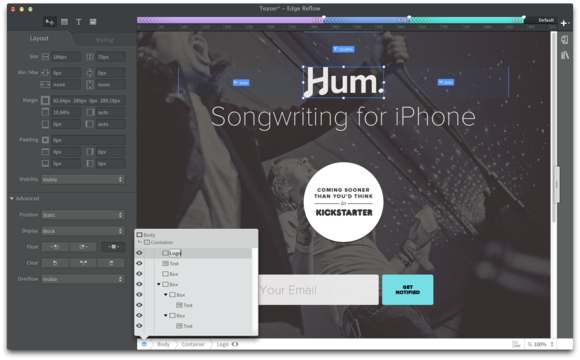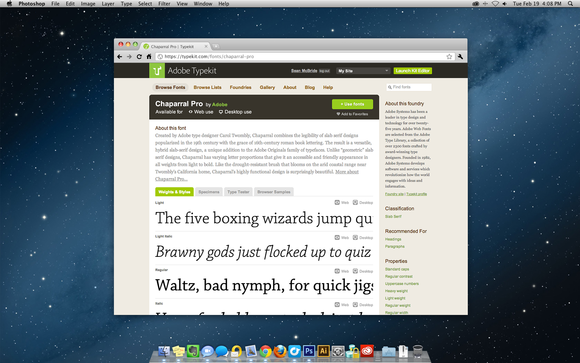In a move that should surprise no one, Adobe announced sweeping changes to its Creative Suite software line and year-old Creative Cloud subscription service. Signaling a new focus on integrating creative services in the cloud with its professional desktop software, Adobe launched a new cloud-based Creative Suite—with a new CC moniker, for Creative Cloud. But it will look familiar. Significant upgrades to all current Creative Suite 6 apps are coming soon, but they will be available only by subscription to Creative Cloud, not traditional software licenses.
Ten years after Adobe corralled its disparate creative apps into a cohesive interoperable suite with a common launch date, the company is propelling those apps into its Creative Cloud subscription service. With updated versions of 15 professional creative applications—for photographers, graphic and Web designers, and video and motion graphic artists—Adobe announced the rebranding at its Max 2013 Creativity Conference keynote. While this transition and collective suite upgrade was announced today, the apps will not be shipping until June 17.
“This is the decision of our company—to focus on Creative Cloud—and it is huge,” said Scott Morris, Adobe's senior marketing director. “It’s an even bigger decision than when we moved to Creative Suite years ago." And it is sure to be controversial. However, Adobe considers the response to its Creative Cloud strategy more than respectable so far, expects some pushback from customers, and is prepared to deal with the fallout. "In the same way [as Creative Suite], there will be customers who have a hard time with it at first. But today our customers are on Creative Suite—they got over it; they saw the benefit of it; and that’s exactly the type of transition we’re going through.” Adobe says Creative Cloud has more than half a million paid members, and more than 2 million total members since it launched in April 2012.
With this update, you can store, sync, and share files via Creative Cloud, on the Mac OS, Windows, iOS, and Android platforms and on Behance, an online creative community Adobe purchased last year that is now integrated with Creative Cloud. Behance lets users exhibit work, get feedback, and generate exposure. With Creative Cloud, Adobe seeks to tame chaotic creative workflows and direct communication conduits away from email and Dropbox toward Behance.
This move comes on the heels of Adobe's recent acknowledgement that it will cease selling shrinkwrapped boxes of its creative apps.
More coverage on Adobe's updates to Photoshop, as well as its publishing, Web design, and video software accompany this news story.
You say CS, we say CC
The new software carries a new name. Instead of Photoshop CS and a version number (CS6, for example), it will be Photoshop CC in the new cloud-based version. It's unclear at this point whether future updates will adopt a new numbered version system. Apart from the cloud venue, Adobe Creative Cloud is the same lineup of professional creative art, design, and photography apps that it’s always been, except the subscription adds a significant number of software services designed to transform the Creative Cloud into a creative community.
Adobe spent the last year constructing a detailed road map of its transition from a traditional software company to a collaborative, cloud-based software behemoth serving individual designers, small shops, and enterprise businesses. Adhering to that plan, it rolled out cloud-based updates to various desktop creative software packages, introduced the Web-oriented Edge suite of Tools & Services, and more.
The new lineup also includes some subscription-only desktop apps, such as Muse, plus some companion mobile apps, such as an updated Kuler color utility. It also includes the Lightroom photo management app—the only Creative Cloud offering that will continue as both a perpetual license and cloud subscription.
Why is Lightroom a special case? Because Adobe makes the distinction between professionals using software for their livelihood and enthusiasts who use it for fun. “Lightroom is tricky because it falls in between," said Morris. "Lots of consumers use Lightroom, but it’s also used by pro photographers. So we’re treating it both ways."
License phase-out
With this transition, Adobe will quit selling perpetual licenses to new creative suite software packages, but will continue to support Creative Suite 6 for compatibility through the next major upgrades of both Mac and Windows operating systems. Adobe will also continue to make CS6 available as a perpetual software license for an unspecified time, and will provide bug fixes and security updates as necessary.
All CS6 suites and individual products continue to be available via download from the company’s site and select retailers and volume licensing is also available through Adobe authorized resellers. However there will be no further feature development for that version. “We have no plans at this time to update CS6, but for folks who are not ready to give up their perpetual licenses, CS6 and all of its component apps will continue to be available just as they are today. For the forseeable future we have no plans to discontinue them," Morris said.
Adobe is the first company in the creative arena to go the all-cloud route—compared with peers like Autodesk, Microsoft, and Quark. “Adobe is the sole company that says this is going to be the focus for our traditional desktop tools, and is going full-on cloud,” Morris says.
Cloud-only features
Adobe offers a number of features with its cloud subscription, such as Sync Fonts, Sync Colors, and Sync Settings, online collaboration, 20GB of cloud storage, Behance, and new training resources that link its cloud services.
With Creative Cloud, Adobe has gone to great lengths to open its software shelf for new users and to introduce new software to larger groups. At one time, it would have been impossible—short of spending hundreds of dollars or camping out at a friend or colleague’s desk—to learn InDesign or Illustrator if you did not own it. With a Creative Cloud subscription, you can download any software package you want. As long as you subscribe, you have the software, which gets updated with new fixes and features automatically. It's no surprise that Creative Cloud emphasizes the educational and collaborative aspects of the subscription to build that kind of interest.
Just because it's called Creative Cloud does not mean that it operates from the cloud. With a subscription, users download the software to their desktops and install and use it the same way they would an electronic download or boxed purchase.













